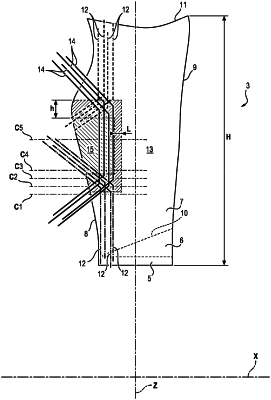| CPC F01D 5/282 (2013.01) [F01D 5/147 (2013.01); F05D 2220/36 (2013.01); F05D 2300/501 (2013.01); F05D 2300/603 (2013.01); F05D 2300/614 (2013.01)] | 20 Claims |

|
1. A fan blade of a turbomachine comprising a structure of composite material comprising a fibrous reinforcement obtained by three-dimensional weaving of strands and a matrix in which the fibrous reinforcement is embedded;
wherein the structure of composite material comprises a leading edge, a trailing edge, an airfoil with an aerodynamic profile configured to extend in an airflow, a root configured to be attached to a fan disk and a strut extending between the root and the airfoil;
wherein the fibrous reinforcement comprises a first portion forming the trailing edge, a second portion forming at least part of the leading edge, and a third portion extending between the first portion and the second portion;
wherein the strands of the fibrous reinforcement comprise first strands having a predefined elongation at break and second strands having an elongation at break greater than the predefined elongation at break of the first strands, the first portion comprising all or part of the first strands, the second portion comprising all or part of the second strands and a density of the second strands increasing progressively in the third portion from the first portion towards the second portion;
wherein the first and second strands comprise warp strands distributed so as to form warp columns; and
wherein percentage, with respect to a total number of warp strands in a warp column of the third portion, of second strands introduced between two columns of immediately adjacent warp strands in the third portion is equal at most to 30%.
|